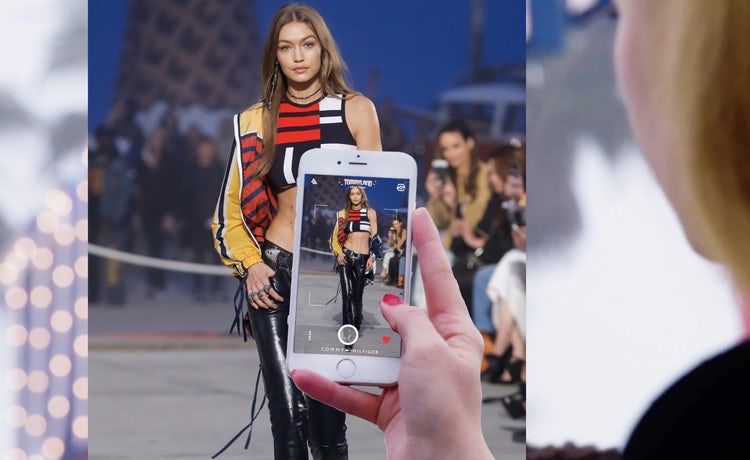How a startup mentality put Tommy Hilfiger at the centre of a fashion revolution
Tommy Hilfiger might be a well-established brand but in order to keep up with today’s always-on consumers and find younger fans chief brand officer Avery Baker has adopted a startup mentality taking cues from tech and entertainment.

Think back to the 1990s and Tommy Hilfiger was one of the most dominant fashion brands on the market. It was the height of cool among young urban consumers, with stars including Kate Moss, Snoop Dogg and the members of Destiny’s Child buying into its preppy style of American sportswear. It tapped into pop culture in a way other brands failed to do, building relationships in a genuine and believable way.
Yet as the brand grew up so too did its audience and Tommy Hilfiger has struggled in recent years to attract subsequent generations.
But all that has changed over the past 12 months. Taking cues from other more forward thinking industries with the launch of its ‘see now buy now’ model #TommyNow, and via a tie up with one of social media’s hottest properties Gigi Hadid, Tommy Hilfiger has once again become a desirable, sought after label. Not just among its core, loyal followers but with a whole new army of younger fans.
“We call it the Gigi effect,” says chief brand officer Avery Baker, talking to Marketing Week at the Cannes Lions Festival last month. “Tommy has always had relationships with people in music, fashion or entertainment. But for us the most important filter is the value any collaboration can bring – what does that person stand for, what do they represent and does that match up with what we stand for as a brand?
“Then, of course, we look at the amount of influence that individual has and the ability their platform has to reach likeminded and also new audiences.”
With 34.9 million followers on Instagram and 5.2 million more on Twitter, Hadid has serious reach. The fact she not only fronted the campaign and walked the catwalk but designed the capsule TommyXGigi collection for the brand helped build that credibility further, says Baker.
Refreshing the brand
The ‘Gigi effect’ is just one element of a major brand refresh that saw Tommy Hilfiger reimagine its womenswear business, not just from a design perspective but how it is brought to life for today’s always-on, ever-more demanding consumers.
As well as enlisting global supermodel Hadid, the brand revolutionised the way the fashion industry works by making items seen on the catwalk available immediately online and in Tommy Hilfiger stores across 70 countries the next day – a process that normally takes six months.
“The fashion industry has to realise it is no longer just competing with itself,” says Baker.

“The level of service that businesses like Uber and Airbnb offer means we have to [keep up]. People won’t suddenly switch their mindset and say ‘for fashion it’s OK that we wait six months’. If it’s happening everywhere else, inevitably people are going to have the same expectations of our industry.”
The brand first experimented with the ‘see now buy now’ concept in New York last September, before launching a festival-inspired show in Los Angeles called Tommyland in February.
In addition to inviting 1,000 press and industry people, Tommy Hilfiger opened its gates to 2,000 consumers, and the show was live-streamed via the brand’s website, racking up 470,000 views – the equivalent of 11,000 hours – across 70 countries worldwide.
We prioritise action and speed over getting it right every single time.
Avery Baker, Tommy Hilfiger
More than 30,000 ‘looks’ were added to people’s wish lists after viewing, with 55% of visitors new to the site. By embracing new technology Tommy Hilfiger has also attracted a younger audience – 35% of which are now under 35.
“One of the biggest challenges we’re facing in the fashion industry is that people are less interested in apparel and are spending less money on it,” she says. “People can get anything for a price so it’s about finding a way to create experiences and a connection that really motivates them to want to be part of the brand and to spend money on it. It’s much more challenging than it used to be.”
The new strategy is already having an impact though, with 17 of the styles showcased during the show selling out in the first 48 hours, leading to a 26% uplift in womenswear sales globally.
Engagement also improved significantly, with 2.5 billion impressions generated across its major channels and over 10 million likes and comments via #TommyNow. Searches for Tommy Hilfiger on Google were also up 60% year-on-year.
“We’re seeing a tremendous halo effect with female consumers across all our different product categories,” adds Baker.
The job now is to take the #TommyNow concept to other markets.
“We want to bring a little piece of Americana to those places in a way that also feels locally relevant and exciting. We think that’s the future of how we can connect with people, not just digitally but personally,” she adds.

The brand will also be looking at how it can adapt the concept for its menswear business.
“All the energy we’re seeing with new consumers around our women’s line is something we believe there is an opportunity to learn from for our men’s line,” she says. “We will have to modify the approach because different things will work for and appeal to men.”
The brand recently enlisted pop music duo The Chainsmokers to become global brand ambassadors for the menswear business, which Baker says “reflects our desire to really connect more with younger consumers and do that in a way that doesn’t alienate our loyal base”.
READ MORE: The secrets of achieving cult status
Adopting a startup mentality
The only way the brand has been able to take shake things up and make such a fundamental shift to its processes is by operating as a startup.
“We’ve been trying to adopt an entrepreneurial, startup mentality within our organisation,” says Baker. “We’ve picked that up from what we see happening in the tech space. There is a mantra today about iterative learning – launch, test, learn, adjust and go back to the drawing board and start again. That’s been really inspiring for us. In that sector you see that some things do fail but if you don’t try you’ll never find the big wins.”
While it might be harder for a business like Tommy Hilfiger that has more legacy systems in place, having that “trust and freedom” to learn as it goes has enabled the brand to move at a far greater pace.
“We prioritise action and speed over getting it right every single time,” Baker adds.
Going forward, Baker will be looking to evolve the #TommyNow concept and explore other opportunities, again taking cues from what other sectors are doing.
Sometimes people say ‘the communication is slowing us down’ but it’s critical if you’re going to go in this direction.
Avery Baker, Tommy Hilfiger
“That’s the beauty of having so many amazing innovations happening constantly in the tech world. Every three months there is a new idea that we can’t wait to explore.”
One such idea is the TMY.GRL chatbot, which has generated more than 46,000 messages since its inception. Tommy Hilfiger has recently taken the concept one-step further by becoming the first brand to integrate its chatbot within outstream video ad formats, working alongside Teads, to enable it to extend its reach beyond Facebook Messenger.
The chatbot lets consumers explore items from the brand’s new collection by asking questions that help identify a customer’s individual tastes and size. Any items suggested by the chatbot can then be bought from the Tommy Hilfiger website where their recommendations will be waiting in the basket.
READ MORE: How Adidas, Just Eat and HTC are using chatbots
Internal shift
Being able to deliver items the minute they leave the catwalk has taken a huge shift internally. All departments, from design and operations through to marketing and point of sale, have got to work together from the initial design to the final execution and delivery to ensure it is a seamless process.
Historically, Baker says there has been “surprisingly little interaction” between teams at fashion brands as they operate with a linear timeline, but she had to rip up everything that had come before in order for the new strategy to work.

“A lot of teams that could bump up against each other are now working more closely than ever before because we’re all working towards one common goal. We’ve had to make roles and responsibilities more clear but there is a much more cohesive prize at the end of the line,” she says.
“To have all these teams work together from the very beginning and create simultaneously you have to be supportive of each other’s work because it’s in the development process. Our teams have really enjoyed getting to know people in the company that they didn’t know before.”
While she’s happy with results, Baker admits it hasn’t been easy to implement such a fundamental shift in the way people work.
“It’s incredibly complicated and time consuming,” she says. “Even just the communication of everything that’s happening – that takes time. Sometimes people say ‘the communication is slowing us down’ but it’s critical if you’re going to go in this direction.”
CMO tenure
Baker has been at Tommy Hilfiger for 20 years, holding various communications, marketing and brand roles during her time with the brand, defying the current trend for far shorter tenure, but she believes the benefits of being wedded to the business for such a long time are vast from a brand perspective.
READ MORE: Why CMO tenure is falling
“I keep learning every day because consumer behaviour is changing so much,” she explains. “Having that insight into the brand has made it easier to expand quite naturally beyond the marketing piece. So when we think about consumer experience and store design, or even collection design – all of those things are of course impacting consumers’ perception of the brand so it has been a very nice evolution to be able to really touch all parts of the experience rather than just one piece of it.”
“It’s hard to imagine after all these years that it will continue to be so interesting but once you open up and go outside the boundaries of the industry that’s when you realise there’s so much more you can explore,” she adds.







